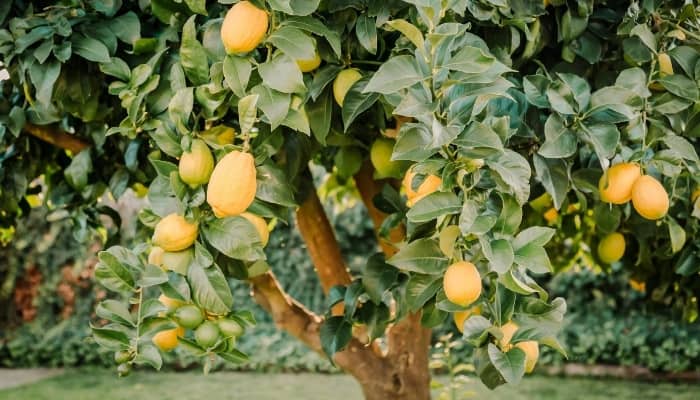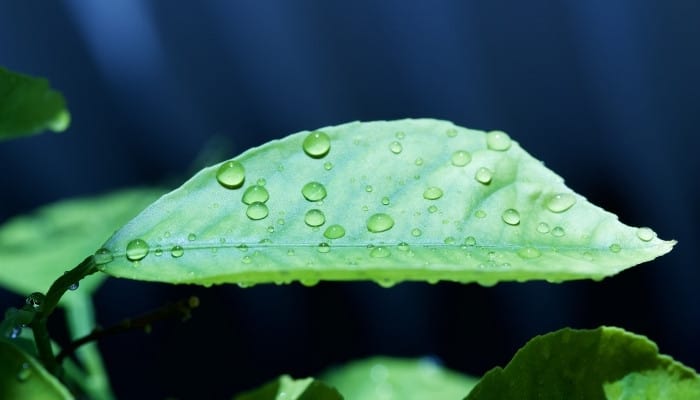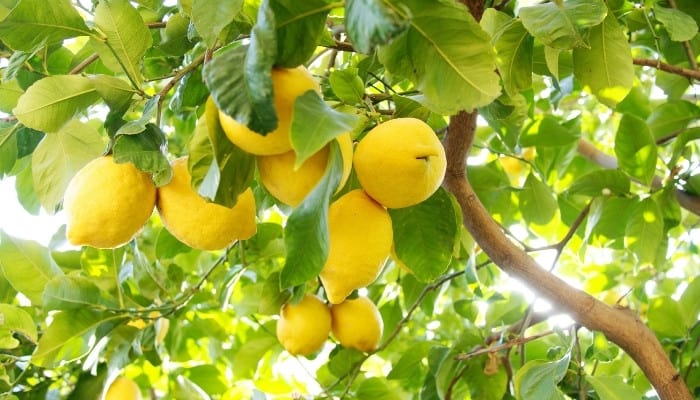There are few things that can compare to the satisfaction of strolling outdoors and handpicking a ripe lemon when it is needed.
Some prefer being able to just walk to the next room, because these versatile plants can be grown indoors as well.
Lemons are a staple in most kitchens, so it comes as no surprise that many people want to grow their own tree.
While these plants are not difficult to grow, many people wonder what a healthy lemon tree should look like.
What should lemon tree leaves look like? Healthy lemon leaves are dark green on top, light green on the bottom, and shaped like elongated ovals with a pointed tip. There should be no curling or discoloration. There is fine ribbing along the leaf, but they appear smooth. It’s normal for young leaves to have a reddish tint.
Lemon trees can be grown in any warm climate and have been thriving in North America since the Spanish conquistadors first brought them over from Europe.
While it is normal for any outdoor plant to suffer occasional damage or disease, the majority of your lemon tree leaves should be lush and healthy.
Lemon Tree Basic Care
Lemon trees are easy to grow as long as you provide them with the right environment. Lemons are more cold sensitive than other citrus varieties and cannot go below 29℉.
This is the main limiting factor for a tree planted outdoors, but you always have the option to move your lemon tree indoors.
Selecting Your Lemon Tree
As with any plant, it is important to choose an overall healthy specimen. Look for a strong trunk, bright green leaves, and no signs of major damage, disease, or pests.
There are also multiple varieties of lemon trees to choose from, although your garden center may just list the tree as “lemon.”
Choosing the variety that best fits your location and climate will give you the best chance of growing a healthy, fruitful tree.
Considerations When Choosing A Lemon Tree
- What To Look For: Strong, healthy rootstock
- Growing Zones: 8-12 (depending on variety)
- Common Types of Lemons: Meyer, Eureka, Pink Variegated
- Space Requirements: Up to 10 feet
- Light Requirements: Full Sun
How Many Types of Lemon Trees Are There?
There are 30 varieties of lemon trees, but some are true lemons and some are hybrids with other citrus varieties. Some of the most common and popular varieties include:
- Lisbon: most popular variety, commonly found in grocery stores
- Eureka: similar to Lisbon but with fewer seeds
- Pink Variegated: fruit with pink flesh and yellow/green striped peel
- Meyer: hybrid variety with lots of sweet juice, a favorite for baking
- Buddha’s Hand: fun addition to home garden, most unique fruit shape
Planting Your Lemon Tree
Once you have chosen your lemon tree, you will want to plant it in the right location.
Choose a spot that gets full sun (6+ hours per day – we explain direct vs. indirect sunlight here) and has soil that drains well.
Dig a hole that is 1.5 times deeper than the nursery pot your tree is in. Lemon trees do not root as deeply as other citrus trees, so they do not require that deep of an initial hole.
The soil should be acidic (pH of 5.5-6.5). This can be amended if your soil has a naturally higher pH.
Since the soil needs to drain well to prevent root rot, you can dig a larger hole and add an acidic soil mix with perlite before planting your tree.
If you live in a cooler climate (growing zone 8 or less), consider planting your lemon tree in a container that can be moved into your home or greenhouse during the winter.
Choose a container that is at least 1.5 times the size of the nursery pot and has a drainage hole.
Caring for Your Lemon Tree

Once your lemon tree is planted, continuous care is important to grow a strong tree that produces plenty of fruit.
Water
Make sure to water your tree frequently for the first couple of weeks after planting. This will help the roots to establish themselves in the new location.
After that, you will only need to water when necessary. During the rainy season, you should not need to add any additional water.
When watering, avoid getting the leaves and fruit wet as this can lead to fungal infections and attract pests.
Mulch
Mulch is not a necessity, but it can be helpful depending on the location of your tree.
If you are in a drier climate, covering the soil in mulch will help lock in moisture and minimize the need for frequent waterings.
However, continuously wet mulch (in humid locations like Florida) can attract pests.
Fertilizer
Lemon trees are heavy feeders and will need frequent fertilizer applications.
Use a balanced fertilizer, like this one designed especially for citrus trees, and set your application schedule based on the directions from your brand.
Potassium is especially important for lemon trees as it promotes photosynthesis and nutrient transport.
Pruning Your Lemon Tree
Pruning is not as important once your tree has matured, but it is especially helpful while the tree is young and growing.
Pruning a young tree will determine the shape. You can train the tree to grow tall or bushy based on how you prune the branches.
You can also prune indoor or container trees to keep them a manageable size.
When your lemon tree is young and small, you can also prune off blossoms and fruit. This will help the plant to focus on growing a stronger trunk and branches.
Since the plant has limited resources, it will usually only focus on one thing at a time – producing fruit or growing larger.
Caring for an Indoor Lemon Tree
Indoor lemon trees can be one of the most rewarding edible plants to grow.
Not only do the yellow fruits add beautiful decor to the home, but the fragrant blossoms will make the house smell lovely.
Your indoor lemon tree should be in a location where it receives as much sun as possible. The plant will thrive in a southern-facing window that gets plenty of direct sunlight.
If you do not have a bright, sunny location for your tree, you can use grow lights, like this hanging version with 120 individual LED lights for full spectrum lighting, for your indoor lemon tree.
Indoor lemon trees will typically grow to 3-5 feet tall, although you can keep them pruned to be smaller.
House the tree in a large pot that has good drainage. The ideal daytime temperature is 70℉ and a little cooler at night.
If possible, move your lemon tree outdoors when the weather is warm enough, especially when the tree is blooming.
This will allow bees and other insects to naturally pollinate the tree. If the tree is left indoors, you will need to hand pollinate the blooms if you want to produce fruit.
What Healthy Lemon Tree Leaves Should Look Like
A healthy lemon tree should have lots of bright green leaves. They should not have dry, drooping, or curling edges. There should not be any yellow or brown spots on the leaves.
Common Lemon Tree Pests and Diseases
Lemon trees can suffer from two fungal infections: leaf spot and root rot. This is commonly caused by sitting water on the leaves and standing water around the roots.
Leaf spot can be treated with a fungicide treatment, but root rot can be hard to treat. In severe cases, it will eventually kill the tree.
Two common pests found on lemon trees are aphids and citrus miners. Citrus miners are actually multiple species of insects that lay their eggs on the tree.
The larvae then burrow into the leaves and eat tunnels throughout the leaves. They are hard to treat, but they will usually not cause permanent damage to the tree.
Aphids are the enemy of most home gardeners. They are sap-sucking insects that target blooms and new growth.
Beneficial insects, like ladybugs, can help control aphid populations. However, insecticidal soap or neem oil treatment can also help.
This organic, 100% pure neem oil has worked well for me in the past.
Can You Eat the Leaves of a Lemon Tree?

Technically, you can eat the leaves of a lemon tree because they are nontoxic to humans. However, they are very fibrous and not very tasty.
One way to use the leaves in cooking is to create a steaming bed or wrap meat in the leaves to infuse a slight lemon flavor while holding in moisture.
Can You Boil Lemon Tree Leaves for Tea?
Lemon tree leaves can be boiled to make tea. Some claim that lemon leaf tea has many health benefits, such as being a sedative and an anti-inflammatory aid.
Most recipes call for adding a sweetener like honey or boiling the leaves with other herbs to add flavor.
Do Lemon Trees Have Thorns?
All lemon trees have thorns, but some varieties have fewer thorns. By using sterile garden shears, you can trim the thorns without affecting the health of the plant.
Why Are My Lemon Tree Leaves Yellow?
By noticing the yellow patterning of the leaves and which leaves on the tree are turning yellow, you can determine what is the likely cause of the leaves turning yellow.
- One side of the tree has yellow leaves: harsh afternoon sun is scorching the leaves
- All leaves are turning yellow: generally caused by cold stress in the winter
- Splotchy or partial yellowing: nutrient deficiency
- Patches of yellowing leaves: pests, especially sap-suckers, draining nutrients from the tree
- Overall slow yellowing: root rot
Why Are My Lemon Tree Leaves Curling?
Lemon tree leaves will curl to conserve moisture, so they are a sign of underwatering, strong winds, and/or low humidity.
Curling leaves can also be caused by transplant shock, overwatering, and moving the plant from indoors to outdoors (or vice versa).
Why Are My Lemon Tree Leaves Turning Yellow and Curling?
When the leaves on your lemon tree are curling and turning yellow, this is a sign that sap-sucking insects, like aphids or scale, are depleting the leaves of vital nutrients.
It can also be a sign of potassium deficiency.
Why Are My Lemon Tree Leaves Falling Off?
It is normal for your lemon tree to drop some leaves during blooming and fruiting because the tree diverts the nutrients into fruit production.
Other causes of falling leaves include strong winds, high heat, nutrient deficiency, and underwatering.
Why Are My Lemon Tree Leaves Wilting?
Wilting leaves on your lemon tree is a sign of overwatering. It can also be a sign that your soil does not drain well, causing water to sit around the roots.
Why Are My Lemon Tree Leaves Turning Brown?
Lemon tree leaves turn brown when they are being scorched by intense sun (typically direct afternoon sunlight), high temperatures, and low humidity.
Why Are My Lemon Tree Leaves Turning White?
White trails forming across the leaves are a sign of leaf miners. These insect larvae tunnel through the inside of the leaf, eating as they go.
If the entire leaf is fading to white, it is a sign of nitrogen deficiency.
Why Do My Lemon tree Leaves Have Yellow Spots?
Yellow spots on your lemon tree leaves are a sign of a zinc or magnesium deficiency.
Why Are My Lemon Tree Leaves Drooping?
Your lemon tree leaves begin to droop when the tree is being overwatered. This can be caused by the leaves becoming heavy with too much moisture.
Also, overwatering can cause root rot, which inhibits the roots’ ability to transport nutrients to the leaves, causing them to droop.
Why Are My Lemon Tree Leaves Pointing Up?
Young lemon tree leaves will orient themselves towards the sun to maximize photosynthesis. The younger leaves produce the most food for the plant.
Are Lemon Tree Leaves Poisonous to Dogs?
Lemon tree leaves are poisonous to dogs because they contain essential oils. The essential oils are highly concentrated in the fruit and blooms, but the leaves still contain trace amounts.
How Do You Care for a Lemon Tree in the Winter?
If your lemon tree is in a container, you can bring it indoors to avoid the cold temperatures. Keep it in a sunny spot, provide additional humidity, and water frequently.
For lemon trees planted outdoors, you can wrap the trunk in burlap (to keep the root temperature higher) if the temperature is dropping below 29℉.
When you are expecting a freeze, spray the entire tree with water because ice maintains a temperature of 32℉. This temperature will not damage the lemon tree.
Conclusion
A well-cared-for lemon tree will provide a bountiful harvest for years to come.
By monitoring the health of the leaves of the lemon tree, you can easily determine when there are any issues and fix them before they turn into a larger problem.

